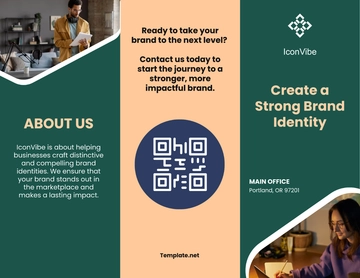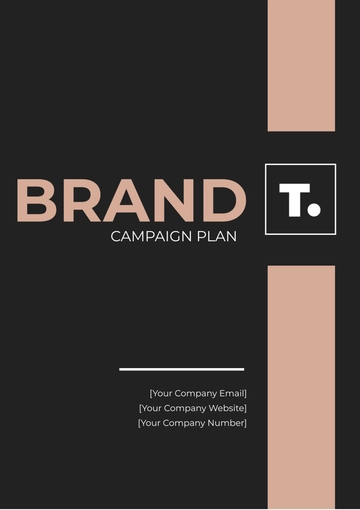Free Brand Layout Performance Report

Prepared by: [Your Name]
Company: [Your Company Name]
Date: January 1, 2050
I. Introduction
This Brand Layout Performance Report evaluates the effectiveness of our brand's visual design elements across various platforms. It focuses on key components like logo placement, color schemes, and typography, assessing their impact on brand recognition and user engagement. The report analyzes current performance metrics, design evaluations, audience feedback, and comparisons with competitors. As we move into 2050, the evolving digital landscape demands a cohesive and appealing brand layout to capture consumer attention. Ultimately, this report aims to identify strengths and areas for improvement to ensure ongoing relevance and competitiveness.
II. Performance Metrics
A. Brand Recognition
Brand recognition metrics are pivotal in understanding how easily our audience identifies our brand through visual elements. The following metrics were evaluated over the last quarter:
Metric | Measurement |
|---|---|
Logo Recall | 86% |
Color Scheme Recognition | 77% |
Typography Familiarity | 64% |
These metrics indicate a strong level of brand recognition, particularly for our logo, which demonstrates a successful design strategy. An 86% logo recall suggests that our visual identity is firmly embedded in the minds of consumers, a critical factor in fostering loyalty and driving repeat business.
B. User Engagement
User engagement assesses how interactions with the brand layout translate into user actions. Below are critical engagement metrics:
Average time spent on the landing page: 3 minutes 25 seconds
Bounce rate: 42%
Click-through rate (CTR) for call-to-action buttons: 6.5%
High engagement rates indicate that users are not only recognizing the brand but are also interested in exploring it further. However, a bounce rate of 42% suggests that there are opportunities to enhance the layout or content to retain users' attention longer.
C. Conversion Rates
This section measures the ratio of users completing desired actions due to effective brand design:
Conversion rate for product sign-ups: 4.8%
Conversion rate for newsletter subscriptions: 7.1%
Overall site conversion rate improvement: 1.2% increase from the previous quarter
The increase in conversion rates signals that our branding efforts are translating into actionable outcomes. However, a detailed analysis may reveal specific areas where the brand layout can be fine-tuned to further increase these figures.
III. Design Evaluation
The brand's design elements are critiqued on their aesthetic appeal, coherence, and influence on brand perception.
A. Logo Placement
The logo is strategically placed to ensure maximum visibility and memorability, with 86% positive feedback regarding its positioning across digital interfaces. A well-placed logo enhances brand recall and reinforces brand identity, essential in today's crowded marketplaces.
B. Color Schemes
The chosen color palette evokes trust and enthusiasm, resonating well with the audience. The primary color scheme achieved a 77% rate of recognition and preference among users. As consumer preferences shift, continuous evaluation of color choices will be vital to maintain relevance.
C. Typography
Typography has been applied consistently across all platforms, with 64% user familiarity reported. This consistency supports overall brand identity strength. However, as digital consumption habits evolve, ongoing assessments of font legibility and style preferences will be essential to keep up with user expectations.
IV. Audience Feedback
User feedback was gathered through surveys and focus groups to assess perception and effectiveness.
A. Positive Feedback
Strong emotional connection with color schemes.
High recognizability and attractiveness of the logo.
Positive feedback indicates that users feel an emotional connection to the brand, a crucial component of brand loyalty. This connection is particularly important in fostering long-term relationships with customers.
B. Areas for Improvement
Typography could be enhanced for increased readability on smaller devices.
More dynamic visual content is suggested by users to increase engagement.
Feedback highlights that while our branding is effective, adjustments in typography and content diversity could significantly enhance user experience.
V. Comparison to Competitors
Analyzing our brand layout relative to competitors provides insights into market positioning and differentiation.
A. Visual Identity
Our brand maintained superior logo visibility compared to our top three competitors, with an 11% higher recognition rate on average. This advantage showcases the strength of our design strategy and sets a strong foundation for brand identity.
B. User Engagement
Engagement metrics like CTR and bounce rates are on par with industry averages, indicating opportunities for refinement to surpass competitors. In a competitive landscape, leveraging insights from these metrics will be essential for continuous improvement.
VI. Recommendations
Based on the evaluations and feedback, the following actionable recommendations are proposed:
Revise typography for better legibility, especially on mobile devices. As more users access content through smartphones, enhancing typography will improve overall user experience.
Introduce additional visual content to enhance user engagement. Diversifying content formats can create a more dynamic and interactive user experience.
Enhance call-to-action design to boost click-through and conversion rates. Reassessing and optimizing CTA placements and designs can drive higher user action and conversions.
VII. Conclusion
This Brand Layout Performance Report underscores the effectiveness of our current design strategy while identifying opportunities for improvement. With high levels of brand recognition and user engagement, the foundation is strong. However, with targeted recommendations, we can further enhance conversion rates and differentiate ourselves from competitors more effectively. Consistent updates and strategic enhancements in design will ensure continued resonance with our target audience and stronger market positioning. As we look ahead to 2050 and beyond, remaining adaptable and responsive to evolving consumer preferences will be crucial for sustained success.
- 100% Customizable, free editor
- Access 1 Million+ Templates, photo’s & graphics
- Download or share as a template
- Click and replace photos, graphics, text, backgrounds
- Resize, crop, AI write & more
- Access advanced editor
Optimize your branding strategy using our Brand Layout Performance Report Template at Template.net. This editable and customizable template provides a structured format to analyze brand performance effectively. Easily modify elements to suit your specific goals, ensuring accurate insights. Utilize our Ai Editor Tool for quick edits and create a report that drives brand success.





























